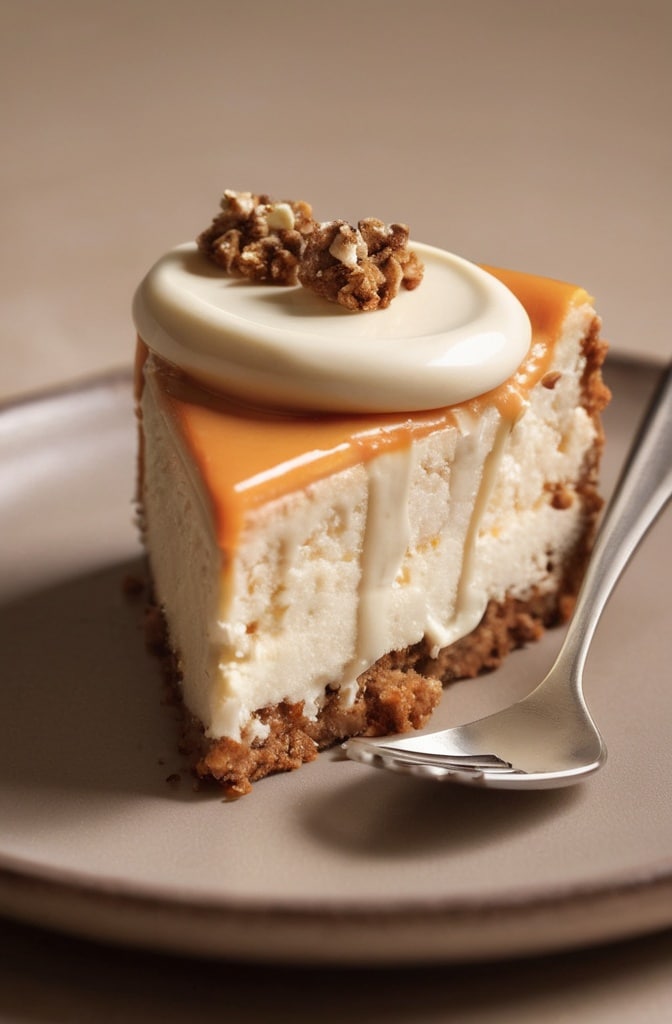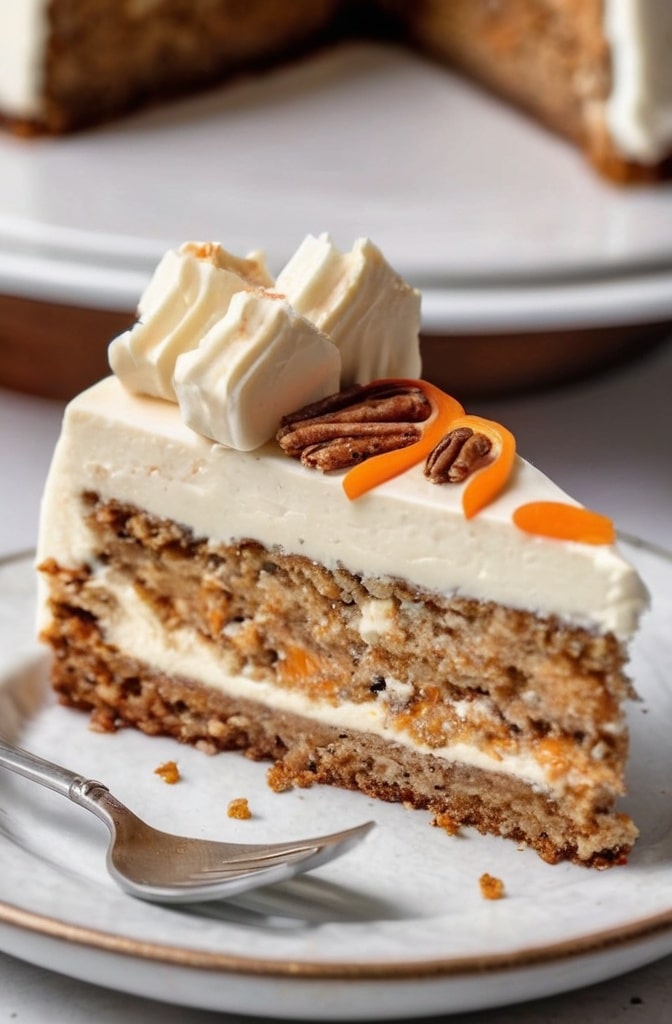I still remember the first time I made a Carrot Cake Cheesecake. It was a rainy Sunday afternoon in my grandmother’s kitchen, and we were looking for a way to use up the abundance of garden carrots. What happened next was nothing short of culinary magic. The earthy sweetness of carrot cake fused with the tangy richness of cheesecake to create a Carrot Cake Cheesecake that was truly extraordinary.
This hybrid dessert takes the best elements of two classic treats and transforms them into something greater than the sum of its parts. You’ll get the warm spices and moist texture of carrot cake alongside the creamy decadence of cheesecake, all topped with a silky cream cheese frosting that brings everything together in perfect harmony.
Ingredients & Substitutions
For the Carrot Cake Layer:
- 1 cup all-purpose flour
- 1 teaspoon baking powder
- 1/2 teaspoon baking soda
- 1 teaspoon ground cinnamon
- 1/4 teaspoon ground nutmeg
- 1/4 teaspoon ground ginger
- 1/4 teaspoon salt
- 3/4 cup granulated sugar
- 2 large eggs, room temperature
- 1/2 cup vegetable oil
- 1 teaspoon vanilla extract
- 1 1/2 cups finely grated carrots (about 3 medium carrots)
- 1/2 cup chopped walnuts or pecans (optional)
- 1/4 cup raisins (optional)
For the Cheesecake Layer:
- 16 oz (2 packages) cream cheese, softened
- 2/3 cup granulated sugar
- 2 large eggs, room temperature
- 1 teaspoon vanilla extract
- 1/4 cup sour cream
- 2 tablespoons all-purpose flour
For the Cream Cheese Frosting:
- 8 oz cream cheese, softened
- 1/4 cup unsalted butter, softened
- 2 cups powdered sugar, sifted
- 1 teaspoon vanilla extract
- Pinch of salt
- 1-2 tablespoons heavy cream (if needed for consistency)
When it comes to flour, you could subsitute up to half of the all-purpose flour with whole wheat for a nuttier flavor profile and added fiber. Can’t do dairy? Plant-based cream cheese works surprisingly well in both the cheesecake layer and frosting, tho you might need to adjust the sugar slightly as some brands are less tangy.
For those looking to reduce sugar, coconut sugar can replace granulated sugar in the cake layer at a 1:1 ratio. It’ll add a subtle caramel note that pairs beautifully with the carrots. Monk fruit sweetener also works well for those watching carb intake, but I’d recommend using about 25% less as it tends to be sweeter.
Fresh carrots are non-negotiable in this recipe—pre-shredded carrots from the store lack moisture and flavor. Choose carrots with their greens still attached for the freshest taste, and grate them yourself using the fine side of a box grater.
Step-by-Step Instructions

Preparing the Pan and Oven
- Preheat your oven to 350°F (175°C). Position the rack in the middle of the oven for even heat distribution. A common mistake is placing cheesecakes too high in the oven, which can cause the top to crack from excessive heat.
- Prepare a 9-inch springform pan by greasing the bottom and sides, then line with parchment paper. Pro tip: spray the pan first so the parchment sticks in place while your pouring in the batters.
- Wrap the outside of the pan with two layers of heavy-duty aluminum foil, making sure it comes up at least 2 inches on all sides. This prevents water from seeping in during the water bath baking process—nothing ruins a cheesecake faster than a soggy bottom!
Making the Carrot Cake Layer
- In a medium bowl, whisk together the flour, baking powder, baking soda, cinnamon, nutmeg, ginger, and salt. Whisking the dry ingredients seperately ensures even distribution of the leavening agents and spices.
- In a large bowl, beat the sugar and eggs until light and fluffy, about 2 minutes. While mixing, drizzle in the oil slowly to create an emulsion that’ll give your cake a tender crumb.
- Stir in the vanilla extract, then fold in the grated carrots until just combined. The moisture from the carrots is crucial for the cake’s texture, which is why you should grate them right before mixing—dont let them sit and dry out.
- Gently fold in the flour mixture until just incorporated. Be careful not to overmix; stop when you still see a few streaks of flour, as overmixing develops gluten and results in a tough cake.
- If using, fold in the chopped nuts and raisins. For enhanced flavor, try toasting the nuts for 5-7 minutes at 350°F before adding them to the batter.
- Spread the carrot cake batter evenly in the prepared springform pan. The layer will seem thin, but it’ll rise during baking.
Creating the Cheesecake Layer
- In a large bowl, beat the softened cream cheese until smooth and creamy, about 2 minutes. It’s absolutely essential that your cream cheese is properly softened to room temperature to avoid lumps—I leave mine out for at least 2 hours before baking.
- Gradually add the sugar and continue beating until the mixture is light and fluffy. Scrape down the sides of the bowl frequently to ensure everything is incorporated.
- Add the eggs one at a time, beating well after each addition. Don’t rush this step; proper incorporation of air now means a lighter cheesecake later.
- Mix in the vanilla extract and sour cream until smooth. The sour cream adds a subtle tang that balances the sweetness while contributing to a silky texture.
- Sprinkle the flour over the mixture and gently fold it in. The small amount of flour helps stabilize the cheesecake and prevents excessive cracking.
- Carefully pour the cheesecake batter over the carrot cake layer, spreading it evenly to the edges. Try pouring over the back of a spoon to minimize the impact on the carrot cake layer beneath.
Baking the Cake
- Place the foil-wrapped springform pan in a larger roasting pan. Pour hot water into the roasting pan until it reaches about halfway up the sides of the springform pan, creating a water bath (bain-marie).
- Bake for 50-60 minutes, or until the center is almost set but still slightly jiggly. The perfect cheesecake should wobble slightly in the center when the pan is gently shaken—think jello, not liquid.
- Turn off the oven, crack the door open slightly, and allow the cheesecake to cool slowly in the oven for about an hour. This gradual cooling prevents the dramatic temperature change that often causes cheesecakes to crack.
- Remove from the oven and water bath, and let cool completely on a wire rack. Once cooled to room temperature, refrigerate for at least 4 hours or overnight. For best flavor development, I actually recommend chilling for a full 24 hours.
Making the Cream Cheese Frosting
- In a medium bowl, beat the softened cream cheese and butter until smooth and creamy. Make sure both are at the same temperature for proper emulsification.
- Gradually add the sifted powdered sugar, mixing on low speed until incorporated, then increase to medium-high and beat until light and fluffy. Sifting is crucial here—it prevents those pesky lumps that can ruin the silky texture of your frosting.
- Add the vanilla extract and salt, continuing to beat until well combined. If the frosting seems too thick, add heavy cream one teaspoon at a time until you reach the desired spreading consistency.
Finishing Touches
- Once the cheesecake has fully chilled, run a thin knife around the edges before releasing the springform. This helps prevent the cake from sticking to the sides and potentially cracking.
- Transfer to a serving plate and spread the cream cheese frosting over the top of the cheesecake. For a more rustic look, create swoops and swirls with the back of a spoon.
- If desired, garnish with additional chopped nuts, a sprinkle of cinnamon, or even some finely grated carrot for color. For a professional touch, try making small carrot shapes from tinted marzipan.
Cooking Techniques & Science
The magic of this dessert lies in the careful balance between two very different batters. Carrot cake is essentially a quick bread that relies on chemical leaveners like baking powder and baking soda to rise. When these ingredients react with the acidic components in the batter, they create carbon dioxide bubbles that expand in the heat of the oven, giving the cake its lift.
In contrast, cheesecake isn’t actually a cake at all—it’s a custard. The eggs in the cheesecake filling coagulate when heated, setting the proteins into a smooth, silky matrix that supports the fat from the cream cheese. This is why we bake cheesecakes low and slow, often in water baths. The water moderates the temperature and provides gentle, even heating that prevents the eggs from curdling or cooking too quickly.

The water bath (or bain-marie) serves another crucial purpose in our recipe. Because the carrot cake layer bakes more quickly than the cheesecake layer, the gentle, humid heat from the water bath helps equalize the baking rates. Without it, you’d likely end up with an overcooked, dry carrot cake underneath a perfectly set cheesecake.
The addition of flour to the cheesecake batter might seem unusual to cheesecake purists, but it serves an important purpose. The starch molecules in flour help stabilize the mixture during baking by absorbing excess moisture and preventing the proteins in the eggs from bonding too tightly. This results in a creamier texture and reduces the likelihood of cracking.
When mixing the carrot cake batter, you’ll notice we use the “muffin method”—combining wet and dry ingredients separately before bringing them together. This technique minimizes gluten development, which is crucial for a tender crumb. Overmixing activates the proteins in flour, creating gluten strands that can make your cake tough and rubbery.
Serving & Pairing Suggestions
This carrot cake cheesecake shines as a standalone dessert, but a few thoughtful accompaniments can elevate it to spectacular heights. Consider serving slices with a small dollop of unsweetened whipped cream to cut through the richness, or a quenelle of cinnamon-spiced crème fraîche for sophisticated contrast.
For a visually striking presentation, place your slice on a plate with a dramatic swoop of cream cheese frosting alongside, then dust half the plate with cinnamon for color contrast. A few fresh berries—particularly blackberries or raspberries—add a welcome pop of color and acidity.
When it comes to beverages, this dessert pairs beautifully with a variety of options. A classic cup of coffee provides the perfect bitter counterpoint to the sweet cake. For something more indulgent, try a small glass of tawny port or cream sherry, both of which echo the cake’s warm spice notes. Non-alcoholic alternatives include masala chai or an orange pekoe tea with a touch of milk.
For a complete dessert spread, this carrot cake cheesecake works well alongside other complementary flavors. Consider serving smaller slices as part of a dessert trio with dark chocolate mousse and a bright citrus sorbet for a balanced flavor progression.
The cake holds up remarkably well in the refrigerator for up to 5 days, making it an excellent make-ahead option for entertaining. In fact, the flavors continue to develop and meld over time, with many tasters preferring it on day two or three. Let slices sit at room temperature for about 20 minutes before serving to allow the flavors to fully bloom and the texture to soften slightly.
Conclusion
Creating this carrot cake cheesecake is more than just combining two beloved desserts—it’s about understanding how different baking techniques can harmonize to create something truly exceptional. The moist, spiced carrot cake provides a sturdy foundation for the creamy cheesecake layer, while the tangy cream cheese frosting brings everything together with its smooth finish.
What makes this recipe truly special is its adaptability. Once you’ve mastered the basic technique, you can customize to suit your preferences—add crushed pineapple to the carrot cake layer for tropical sweetness, incorporate a cinnamon graham cracker crust below, or swirl caramel through the cheesecake layer for extra indulgence.
The key to success lies in respecting the timing—don’t rush the cooling process, and allow for proper chilling time. Your patience will be rewarded with a showstopping dessert that elegantly bridges the gap between homey comfort food and sophisticated patisserie.
FAQs About Carrot Cake Cheesecake
Can I make this dessert ahead of time?
Absolutely! In fact, I’d recommend making it 1-2 days in advance. The flavors have time to meld and develop, resulting in an even better taste profile. Just keep it refrigerated and add the frosting no more than 24 hours before serving for the freshest flavor.
Why did my cheesecake crack?
Cracking usually happens due to dramatic temperature changes or overmixing. Make sure you’re using the water bath method, cooling the cake slowly in the oven, and that all your ingredients are at room temperature before mixing. Also, be careful not to incorporate too much air when beating the cream cheese mixture.
Can I freeze this carrot cake cheesecake?
Yes, it freezes beautifully! Freeze it unfrosted, tightly wrapped in plastic wrap and aluminum foil, for up to 2 months. Thaw overnight in the refrigerator, then add the frosting just before serving. The texture might be slightly different but still delicious.
How finely should I grate the carrots?
Use the small holes on your box grater for the best texture. You want the carrots fine enough to cook properly and blend into the cake, but not so fine that they turn to mush. Avoid using a food processor, which tends to make the carrots too wet and can result in a soggy cake.
Can I make this recipe without nuts for allergy concerns?
Definitely! The nuts are entirely optional. For a similar crunch without allergens, try adding 1/4 cup of sunflower seeds or even a sprinkle of hemp hearts. Alternatively, increase the carrots slightly to maintain moisture without adding any crunchy elements.

